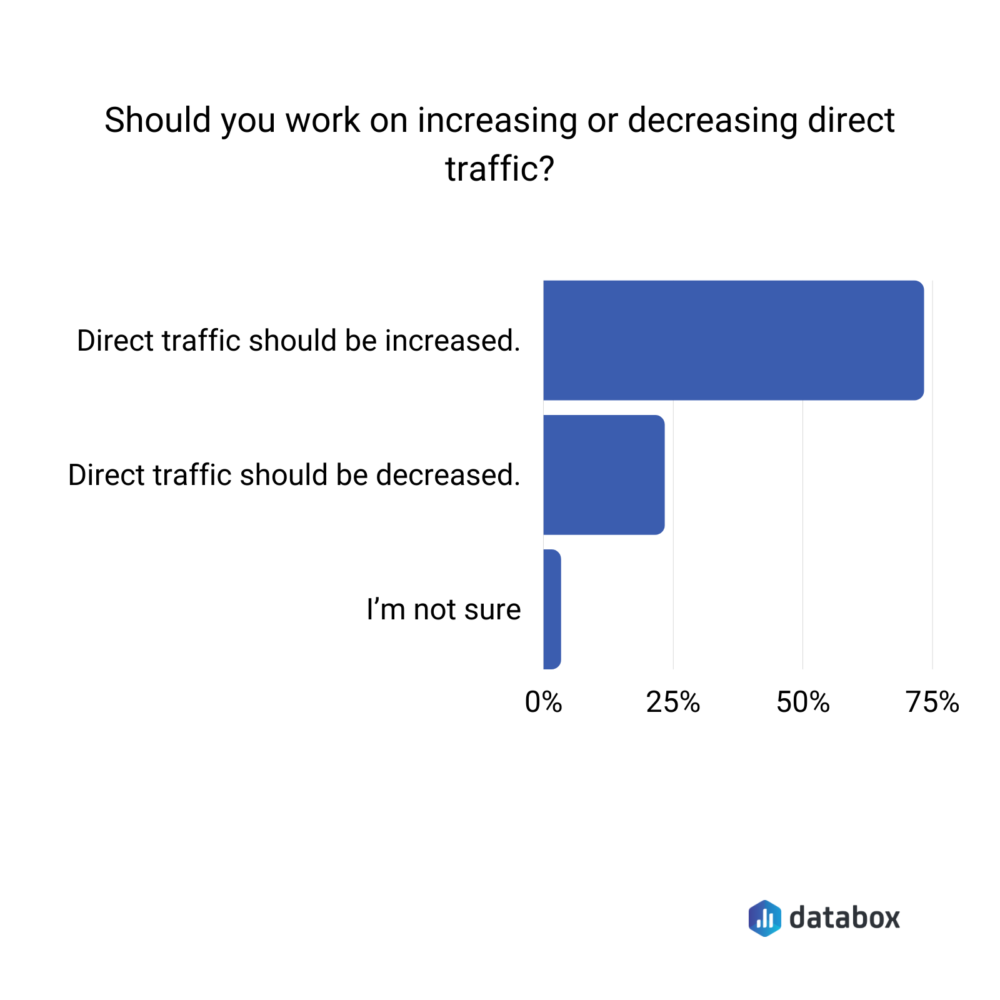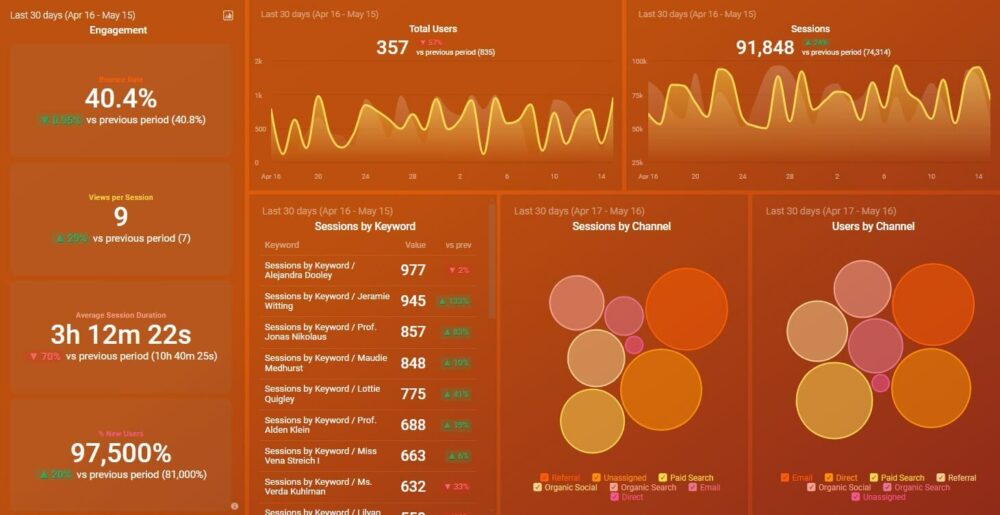Table of contents
If you have ever tried to measure word-of-mouth traffic, you know how frustrating it can be.
You have a sneaky sense that your recent podcast ad, event sponsorship, or increased participation in a particular Slack community is leading to more brand awareness and sales, but you aren’t totally sure.
That’s when looking at your direct traffic more closely in Google Analytics can help you confirm or deny your suspicions.
In this post, we’re taking a closer look at what you can learn about your brand from analyzing direct traffic in Google Analytics.
- What does direct traffic mean?
- Is direct traffic good or bad?
- 4 Things you can learn about your brand by analyzing direct traffic in Google Analytics
- Monitor and analyze direct traffic in Databox
What Does Direct Traffic Mean?
If you are new to Google Analytics, then you might think direct traffic is just visitors typing in your brand/URL. While that does make up a lot of direct traffic, that is far from the only reason.
Additional reasons for seeing direct traffic include big press mentions, dark social traffic (from places like Slack communities, Whatsapp, etc.), improper pixel setup, incorrect cross-domain tracking, spambots, and more.
So, it should come as no surprise that 60% of the marketers we surveyed pay a lot of attention to direct traffic. Paying attention to direct traffic can tell you what’s working as well as help you spot potential problems early.
Is Direct Traffic Good or Bad?
In terms of whether direct traffic is good or bad, the majority of our respondents (73.33%) believe that it’s good and that it should be increased.

“Direct traffic means that people are searching for your brand directly,” says Claire Westbrook of LSAT Prep Hero. “If you see an increase in direct traffic, it means your message is resonating with your target audience.”
Ali Saeed of Ali Agency says, “You’ll find that those who directly type your website’s address are the ones most likely to purchase your products or services. This is because they have previously purchased from you and so remember the website well, making them more likely to purchase again from you. Thus, increasing direct traffic is essential within both B2C and B2B industries.”
Dan Ni of Messaged.com adds, “It is a misconception that direct traffic is a bad thing but still it is something that at times becomes unavoidable. How you manage it counts more, as it can be a positive thing for you.”
And, 23.33% of respondents believe that direct traffic should be decreased.
For instance, Emma Cimolini of Routific explains, “Direct traffic can be driven by an infinite number of user behaviors — the more data we have on specific traffic sources, the better.”
Sasha Matviienko of Citadel adds, “I think, in Google Analytics Direct traffic says pretty much “we don’t know where this user came from”. That’s why every business should aim to have as much clarity as possible.”
PRO TIP: Save Time Creating Your Google Analytics 4 Traffic Dashboard
Yes, you can DIY in Google Analytics 4, but what if you would prefer a simpler, easier route? After all, once you learn how it’s done, you still have to choose the right metrics and design your custom dashboard to answer the important questions your stakeholders have, for example:
- How many people are visiting my website?
- Which channels bring in the most users?
- How engaged are my users?
- How well is my website keyword optimization performing?
and more…
Now you can benefit from the experience of Google Analytics experts, who have put together a great Databox template showing all the most important website traffic KPIs. This template allows for easy integration with scheduled report delivery. It’s simple to implement and start using as a standalone dashboard or in marketing reports!

You can easily set it up in just a few clicks – no coding required.
To set up the dashboard, follow these 3 simple steps:
Step 1: Get the template
Step 2: Connect your Google Analytics 4 account with Databox.
Step 3: Watch your dashboard populate in seconds.
4 Things You Can Learn About Your Brand by Analyzing Direct Traffic in Google Analytics
Regardless of how you feel about direct traffic, there is no denying you can learn stuff by analyzing this traffic, such as:
- Measuring brand awareness
- Learning more about user paths
- Identifying users’ content preferences
- See how often people return to your site
1. Measure brand awareness
Brand awareness is a fuzzy metric. Looking at your direct traffic can help you better quantify if brand awareness is increasing.
“The number one thing I’ve learned by analyzing our direct traffic is how our paid advertising and organic efforts are resulting in brand recognition and growth,” says Evan Tarver of Selling Signals. “When analyzing paid or organic traffic, there’s no way to measure brand equity growth. With direct traffic, however, you can use it to assess the growth and recognition of your overall brand and how your paid and organic efforts are resulting in evangelist or word-of-mouth marketing. Direct traffic is also a helpful measure when conducting marketing that isn’t easy to track, such as holding an event or paying for a conference booth, results in traffic to your website.”
Kas Szatyłowicz of V7 adds, “My key learning is this: Direct traffic is rarely “direct”. Your brand is your business card, and 98% of people will do their research before they decide to become your customers.
Upon analyzing V7’s direct traffic in Google Analytics, I’ve understood the true power of the multi-touch attribution model. It’s imperative that you don’t just let things flow—be diligent about analyzing the true source of your traffic. Some people might come across your brand months before actually converting. They could have seen ads, a webinar, or social media posts before actually typing your website’s URL in their browsers. Personally, I’ve learned that a big chunk of V7’s direct traffic comes from dark social sites such as Slack and Discord communities—and that helped us double down our efforts on staying more active and attracting even more potential users.”
It can also help you identify potential roadblocks to increased word-of-mouth traffic.
For instance, Roy Morejon of Enventys Partners says, “It may sound silly, but one of the things we learned about our brand is how much people struggle to properly spell our name, Enventys Partners. Direct traffic often stems from type-ins, where people simply enter your URL into their browser. We weren’t getting much direct traffic from type-ins, which honestly didn’t bother us, but when we did some detective work we realized that people struggle with ‘Enventys’, leading to almost no direct traffic from type-ins. It was an interesting and important thing to realize about our brand.”
2. Learn more about user paths
It is not enough to know that you are getting more direct traffic. You also should know what they are doing on your website after they get there and how it may differ from users coming from other channels, like paid ads, or organic social media.
“Essentially in the case of direct traffic, the most important thing to focus on is what our visitors do on our site while they’re visiting,” says James Shalhoub of Finn. “This information helps shape how I brand my company and how we design our website by showing where people spend the most time. On top of that, these visitors who browse our site represent an important majority of traffic we observe when strategizing for our conversion rates–especially when they are deciding to buy our products–so those analytics clearly impact our sales strategy.
Without a doubt, some of our most valuable customers come to our website directly to purchase products. Obviously, there is spam mixed into these numbers, but we can eliminate most of them by looking at our bounce rates. The rest might be there to browse, read an article, or look for an answer to a question!
Either way, we shape our brand around what is most engaging.”
PRO TIP: Using reporting software allows you to gain a deeper understanding of your website’s traffic metrics and user behavior, enabling you to make data-driven decisions and optimize your marketing strategy.
Related: Get the Most Out of Google Analytics’ Behavior Flow Report with These 6 Tips
3. Identify users’ content preferences
If you get a lot of direct traffic to your blog, podcast, or other assets, you can learn what types of content perform the best for your desired goals.
“Direct traffic isn’t a bad thing,” says June Escalada of Photoshop Buzz. “In a way, it shows that my content is helpful, that’s why users save it in bookmarks. These users could be my fans or even subscribers.
So from analyzing direct traffic in Google Analytics, I can see popular pages that attract direct traffic. From there, I can see more data and learn more details about each page.
For example, I can see what type of content users spend more time on, what attracts new users, and the type of content that brings more interaction or engagement. Knowing the popular category from your site can also be helpful for creating new content and marketing campaigns.
By analyzing the pages that attract direct traffic, I can also see some weaknesses of the pages. For example, some pages can have a lot of page views but a low conversion rate or average time on screen. In this case, I’ll need to come up with ideas to increase engagement. These data can be very important to consider because you can optimize popular pages to attract more traffic.”
For instance, Alex Buchnev of Paddling Space, adds, “From analyzing direct traffic in Google Analytics, I have learned that the articles on my website analyzing the products and comparing them with others are my most visited page. Consumers would tend to peruse these first before making a purchase using a direct link from the article. This knowledge encouraged me to put these articles into one of the priorities in marketing, making the analysis of the paddles’ features in-depth but written in a way that even first-time buyers of paddles can understand.”
Related: 7 Actionable Ways to Improve Website Traffic Quality
4. See how often people return to your site
Since repeat visitors and customers tend to show up as direct traffic, direct traffic can tell you how often people return to your site.
“We were actually surprised how many of them are recurring and how loyal most of our readers base is, as we don’t have a login area so we solely depend on these metrics to better understand our readers,” says Benjamin Talin of MoreThanDigital. “Especially after MoreThanDigital grew to be a worldwide leading digital initiative we long underestimated the need of the recurring users, the flow they had, and why they returned.”
Stephen Curry of CocoSign adds, “When distributing the links we use tags. Filtering out those tags while building the reports helped us find out that we have been getting a big chunk of direct traffic from repetitive customers and referrals.
Almost 43% of direct traffic comes from referrals and 30% from repetitive customers (as they directly convert) while we are getting only 27% from unknown resources. Looking at the referrals system we are planning to increase the deals for our referrals to increase the conversion rate.”
Monitor and Analyze Direct Traffic in Databox
From measuring brand awareness to analyzing user behavior and content preferences, there is a lot you can learn from analyzing your direct traffic in Google Analytics. Connecting your Google Analytics account in Databox takes seconds, and it allows you to monitor your website traffic faster, alongside all of your most important sales and marketing metrics. Get started for free today.








![How to Leverage Your Website Analytics to Acquire New Customers? [Research Findings Based on 100+ Companies]](https://cdnwebsite.databox.com/wp-content/uploads/2022/10/10044001/google-analytics-4-metrics-and-dimensions-guide-1000x563.png)

![High Shopping Cart Abandonment Rate: Causes and Potential Solutions [Insights from 65+ Experts]](https://cdnwebsite.databox.com/wp-content/uploads/2022/01/17041843/ecommerce-challenges-1000x563.jpg)



